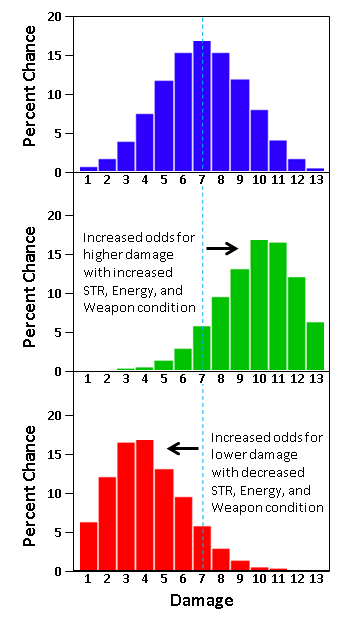Battle Engine
Contents |
Battle Engine Explained
Definitions
| Match | A complete fight between two characters. A match has n rounds. |
| Round | A round includes two turns, one for the attacker and one for defender |
| Turn | A turn may includes n (consecutive)=Battle Engine Explained= |
How it works
Initiative Computation
Initiative (who will attack first) will be computed at the start of every round and will depend on the reach attribute of each character’s weapon. A character using a weapon with a longer reach than his/her opponent will have better odds of gaining the initiative. If the weapons have the same reach, each character has a equal chance of gaining the initiative.
Initiative = f( Attacker_Weapon_Length, Defender_Weapon_Length )
Consecutive Hits Computation
Range 1-3. Consecutive hits are negatively affected by the attacking character’s weapon weight and weapon length, and positively affected by the attacking character’s strength and energy levels. Stunned characters cannot attack.
Consecutive attacks number = f( Weapon_Length (Reach), Strength, Energy )
Hit and Miss Chance Computation
Logic to hit or miss depends on the ratio between Attacker and Defender Dexterities.
Hit_Percentage = f( Attacker Dexterity, Defender Dexterity )
Note: If a character is stunned the attacker has a 100% chance to hit the opponent.
Damage Computation
Dealt damage depends from the following factors:
- Weapon Damage
- Weapon Condition
- Strength
- Energy
- Defender AC
Base Damage
Base Damage = f ( Weapon Damage, Weapon Condition, Strength, Energy) + Strength / 6
The Base Damage is randomly selected within the range of damage values for the equipped weapon. With a Strength value of 10, an energy value of 50%, and a weapon condition of 50%, the damage will be randomly selected using a Normal (Gaussian) distribution centered on the mean of the weapon’s damage range. Thus, if the range is 1-7, a 4 will have the best odds of being rolled and a 1 and a 7 would have the worst odds of being rolled.
- With increasing Strength, Energy and Weapon Condition, the distribution is skewed more toward the maximum of the range.
- With decreasing Strength, Energy and Weapon Condition, the distribution is skewed more toward the minimum of the range.
The Base Damage is then partitioned in Blunt Damage and Cutting Damage accordingly to the weapon Cutting Damage/Blunt Damage. For example if the Base Damage with a fauchard is 10, Blunt damage will be 5 and Cutting Damage 5. Check Weapons Table for useful data.
Blunt Damage
Effect: Stunning an opponent
Cutting Damage
Effect: Bleed Damage
The Critical Hit
Energy consumption
Energy is very important in battle (for example you see in the previous formula that impacts the number of consecutive hits). The energy consumed for each hit will depend on:
- Weapon weight;
- War encumbrance;
- Strength;
- Constitution;
Energy depleted for each attack = f( Weapon_Weight, War_Encumbrance, Strength ) Energy restored for each attack = f( Constitution )
War Encumbrance
War encumbrance is computed as follows:
War Encumberance = (Equipped items weight)/Base_Transportable_Weight
where
Base_transportable_weight = 100 - power(abs( strength - 20 ), 1.3) Kg

